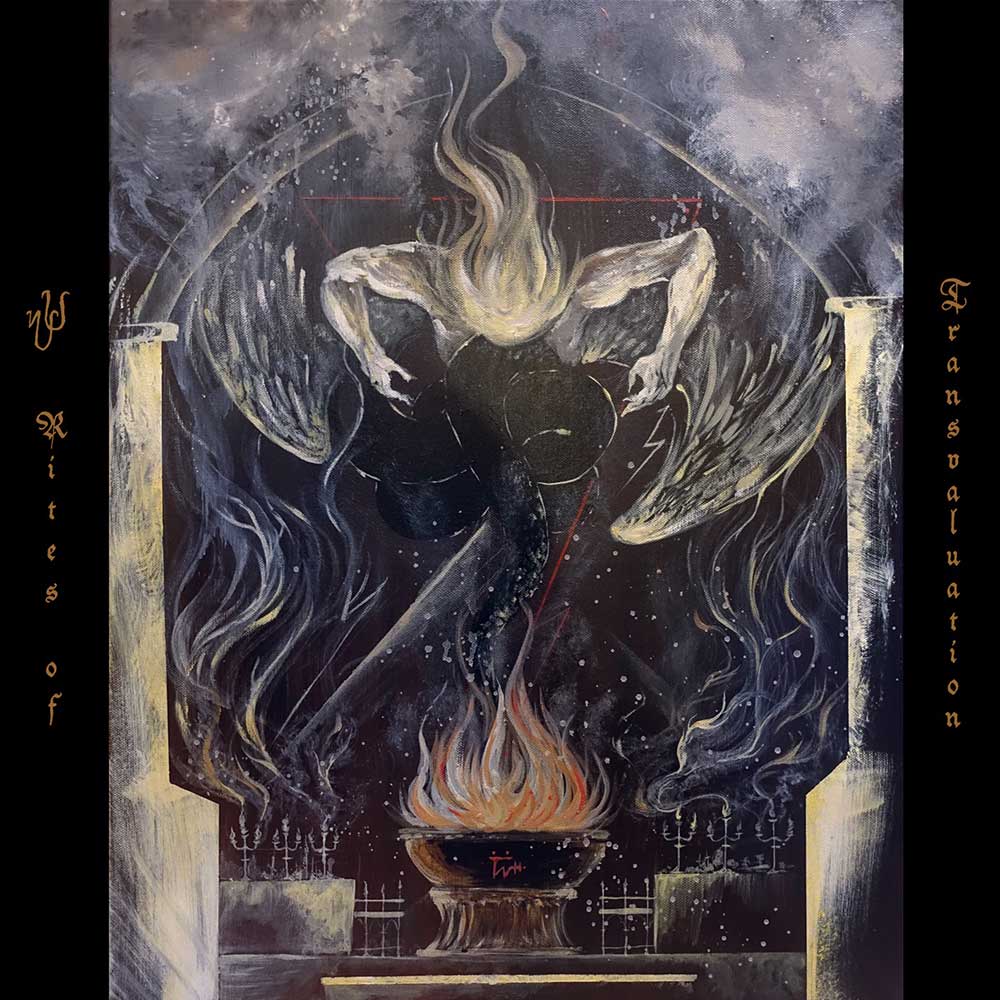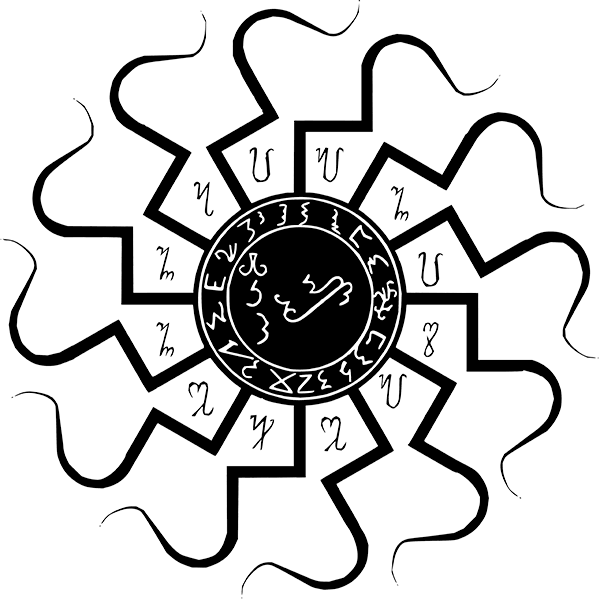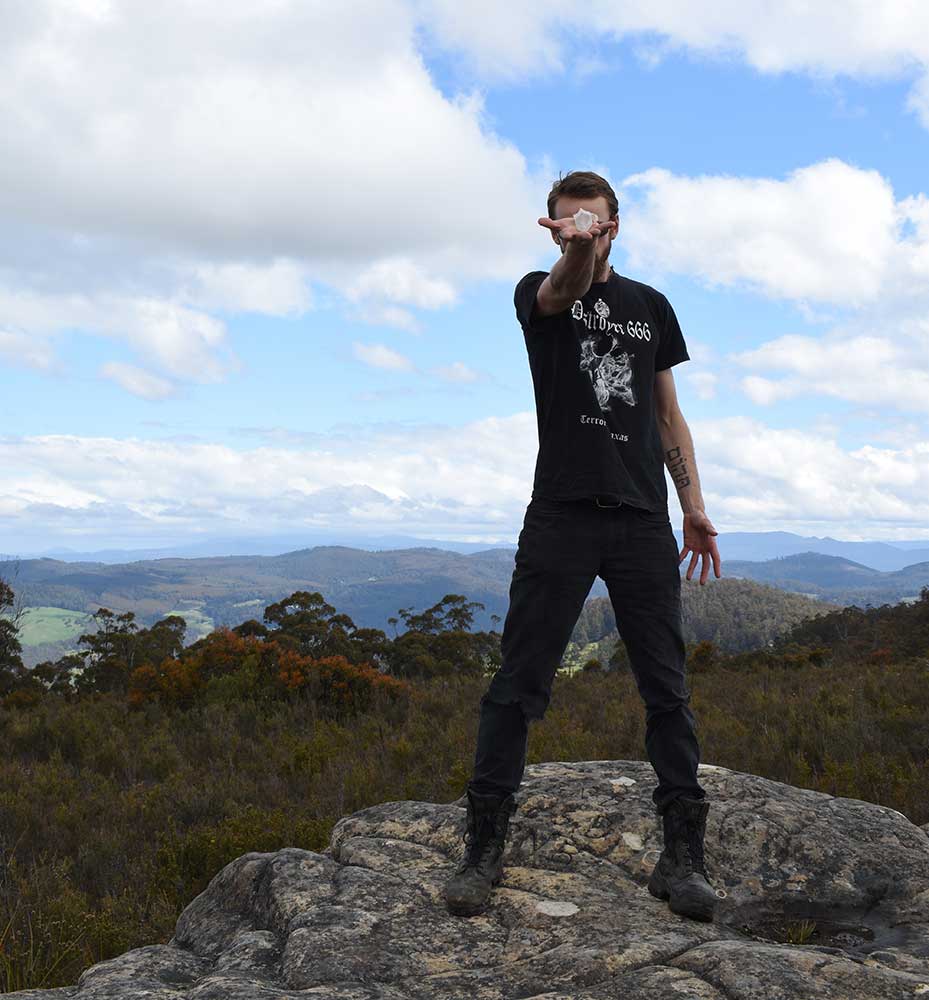Ignis Gehenna
2020-11-25
by Niklas Göransson
Serpentine energies slither through the crooked cross: a conversation about creation and destruction with Aldhamme of Australian black metal band Ignis Gehenna.
– “Rites of Transvaluation” is the second album of IGNIS GEHENNA; one could say it picks up where “Baleful Scarlet Star” left off, since most of the material was recorded around the same time. It was released as a digipak CD trough my new label, Aeon of Fire Music, on November 1, 2020. Clocking in at thirty-seven minutes, it brushes between either a short album or a long EP. Besides three black metal tracks, it contains an experimental piece which delves into the spheres of noise, industrial, and dark ambient – a form of sonic expression I intend to explore further on future releases.
IGNIS GEHENNA started out as a long-distance collaboration between Aldhamme – formerly known as Nihilifier – and an American musician known as Archfiend. They released a demo in 2008 and then an EP in 2010, followed by five years of dormancy whilst Aldhamme focused on Sydney-based black metal band EREBUS ENTHRONED. Meanwhile, Archfiend disappeared from the scene entirely.
– As EREBUS ENTHRONED was dissolving and everyone involved in it took on new trajectories, I came into acquiring and borrowing some recording gear to track a few songs I’d been working on for the better part of six years. Over the course of several incredibly focussed and frenzied sessions, the material was exhumed from the hinterlands of my mind into perceivable form. Hither to that point, this music had existed entirely within me and was only brought out when I practised it on guitar. An album just shy of eighty minutes emerged, so, after some consideration, I chose to leave out three of the tracks in order to make it more digestible and spend time working on the lyrics for two of them, “Sulphur Pit” and “Rites of Transvaluation”. A year later, I recorded the vocal parts in a little black cabin out the back of my house.
That would’ve been 2016, so why didn’t it come out until now?
– Honestly, the wait between albums came down to just being immersed in a lot of other things in my life. In amidst it all, I’d chip away at certain parts – building and dismantling them until I was happy with everything. The addition of the track “Numenos Fyrphos” was the final touch. While my artistic nature is still rooted in restless hunger, over recent years I’ve developed a lot more patience than I once had and am able to step back from things to allow perspective and breathing space. I’ve been working on new material for a while now, music which will be featured on a split album alongside a long-time friend of mine. More on that in the not too distant future.

Reading an older interview, I noticed that Aldhamme mentioned “Numenos Fyrphos” – the aforementioned non-metal track – as the name of a separate project.
– NUMENOS FYRPHOS began as somewhat of a separate entity to IGNIS GEHENNA – channelling and expressing similar muses but through different forms of music, linked through intent to presence an energy of dark internal fire and to wrest a glimpse of beyond. Two largely ad-lib performances happened a few years ago, but the project has been publicly dormant since. As the track was being crafted by myself and a member of RUINER AND THE THRESHOLD FORMS, which is an experimental outfit I’m also active in, it became apparent that the ideal title had been there before me all along. Both musical entities are unified in expression – they just have different executions thereof, so the merging is an organic one.
I’ve never been hugely into noise and power electronics, but I have listened a lot to BRIGHTER DEATH NOW; this song reminds me partly of BDN. Then again, that might be my ignorance speaking as I’m sure there are many nuances in this type of music.
– Your comparison to BRIGHTER DEATH NOW is flattering, as they are a band I respect. I’m honestly no buff on the noise and industrial worlds myself; I am perhaps waist-deep in a scene that descends to the bathyal zone. I do love a lot of the old Cold Meat bands though: MZ.412 are a favourite, for sure, and their militant ritualistic atmosphere would be counted as inspiration for the piece.
My only objection is that the Oppenheimer quote featured in the track, sampled from a 1965 television interview, is a bit overused by now. Robert Oppenheimer was a theoretical physicist who led the research team behind the ‘Manhattan Project’, the US military’s efforts to develop nuclear weapons. Whilst overseeing the first atomic detonation known to have occurred anywhere on earth, the Trinity test in New Mexico, July 1945, Oppenheimer realised how the radiant man-made sun lighting up the entire desert truly hallmarked the dawn of a new age of human warfare. Contemplating the implications, his mind was drawn to a line from Hindu scripture: ‘Now I am become Death, the destroyer of worlds.’ In chapter eleven of the Bhagavad Gita, a warrior prince named Arjuna commands an army about to do battle against an opposing host containing both family and friends. Ravaged by indecision, he consults his charioteer, Lord Krishna, who is an incarnation of the god Vishnu. Krishna explains to him the concept of dharma – a higher philosophy making it a sacred duty for the warrior to carry out his martial responsibilities, regardless of personal objections. Because no matter what action Arjuna decides to pursue, the outcome lies is in the hands of fate. The soldier is only obligated to fight as hard as he can, neither rejoicing nor mourning the outcome, for who stands and who falls is determined by the gods. To drive the point home, Krishna takes on his universal form as a monstrous being with many arms, mouths, and eyes before delivering the line Oppenheimer immortalised in the Western consciousness. Worthy of note is that Hinduism espouses a non-linear concept of time, which means that dissolution inevitably entails the birth of something new; the destroyer of worlds is also a creator. Oppenheimer was not a Hindu in the devotional sense that he subscribed to their pantheon, but he found it helpful as a life philosophy and for justifying his work.
– It’s a fair observation that ‘I am become death…’ has been used a lot, especially in metal. However, my objective with “Numenos Fyrphos” was to create a sonic collage in which sounds, frequencies, and samples were treated in a way similar to how one would lay out a visual collage with backgrounds, textures, features, figures, archetypes, words, and symbols. The track draws its inspiration from the inherent darkness of the modern, ancient, man-made, and natural worlds. “Numenos Fyrphos” is a phonetic spelling of ‘numinous fyrfos’ – the swastika, a symbol I’ve long resonated with and hold a deep reverence for in all its ubiquitous emanations. The title was pieced together as somewhat of a linguistic sigil, to illustrate the notion of a serpentine energy latent within mankind, the cosmos, and nature at large. The swastika is an omnipresent symbol all over the world and the power it expresses lies woven as a source of inspiration beneath the fabric of the piece, symbolising the endless flux between life and death, time and space, form and force, and creation and destruction. As such, I felt Oppenheimer’s quote referencing the line in the Bhagavad Gita was apt and aided in piecing together this collage of apocalyptic cultism.

In a prior conversation, my interviewee pointed out that Aldhamme is the name he now goes by in a metal context – as opposed to Nihilifer, the moniker he used in EREBUS ENTHRONED.
– On both IGNIS GEHENNA albums, I’ve chosen to forgo the use of musician credits, name, or pseudonym; it felt unnecessary in what I was doing. The CD booklet of “Baleful Scarlet Star” features a photo of myself clad in black and wearing a theatrical mask with tendrils emerging from the mouth. This faceless imagery was designed to involve myself within the art rather than establishing an anonymous entity. I took the name Aldhamme about six years ago, when I was working with a small south-eastern Australian group practising ritual magic plus a number of complimentary activities such as martial arts, hiking, bushcraft, stargazing, and so on. I stumbled across the word al-dhammé, or ‘blood-letter’, in a book called A History of Secret Societies; it’s referred to as a ritual knife used to administer the wound of initiation. This spoke to me on many levels, as the sacrifice of blood is a practice I hold a lot of reverence for. No matter the amount of blood, it is seen as a gesture of genuine intent. I have little concern if others refer to me as Nihilifer, it’s just that I no longer resonate with that name – but in terms of utilising a moniker, Aldhamme is what I’ve now chosen to represent my artistic output.
Referring again to an older interview, I noticed how this name change seems to have coincided with his relocation from the urban metropolis of Sydney to Tasmania – an island renowned for its stunning natural surroundings.
– Nihilifer – the bearer of nothingness – was reflective of my satanism at a particular point in life. As for dear old Sydney, you wouldn’t be wrong to assume such a place to breed a healthy lung-fill of nihilism. There is a romanticism to the city’s ugliness I still love; however, moving to regional southern Tasmania was the right choice at a crossroads in my life where much was cast to the winds of destiny. Save for growing up near the ocean, it’s the first time in my life I’ve lived so immersed in the natural world. I don’t think I’ve ever felt more balanced before. The western half of the state is largely wilderness of ancient forests meeting titanic mountain ranges, with rapidly changing and hostile conditions entwined in sublime beauty. Beauty and terror: two words woven in yin and yang that to me express nature as she is.

Aldhamme also mentioned a close connection between the thematic content of IGNIS GEHENNA and personal experiences – in the sense that many of his lyrics are based on actual real-life events.
– For example, “Serpent Oracle”, which opens “Baleful Scarlet Star”, draws inspiration from a strange moment in time I had exploring a network of old military bunkers on Sydney’s coastline. I made my way into a windowless room with steel walls and spent some time conducting an ad-lib ritual, seeking to entreat diabolic forces into the place. As I was leaving, I crossed paths with a red-bellied black snake; it slithered right up to my feet and arched up with an aggressive hiss. Time stood still as we exchanged a transfixed gaze before it lowered its head and moved along. Lost in this trance-like moment, fear turned to a calm stillness and beautiful recognition of this synchronicity. “Melas Oneroi” from the same album was inspired by the emotions and states of mind following a Rite of Regurgitation, which is a form of shadow-work intended to rouse the darkest, most repressed and reviling parts of the psyche out into full view. Some poetic phrases in these songs illustrate moments remembered and synchronicities observed. All of this – experiences and perceptions, dreams, strong but abstract feelings, and my attempts at articulating them – comes together and inspires my words to paint a vivid picture. At least that is my aim.
As another example, he mentions “Sulphur Pit” – the “Rites of Transvaluation” opener, an old demo track re-written for the album.
– Inherently, it’s about perceiving a sense of cosmic dread before forces which dwarf us unimaginably. This song is intended to express a conscious will to align with them; to evolve and transform. An alchemy of becoming in league with inhuman forces. The title certainly took its own transformation from what you would expect it to mean in the early demo years to now, as the element of sulphur signifies the active principle of change within the only place you can rise from… the pit. “Threshold” emerges next as a predominantly instrumental piece, intended as a platform of meditation on the notion of power generated through the clashing and union of polar opposites, as signified by the chanting of the Kenaz, Dagaz and Isa runes. The dawn between fire and ice. Furthermore, I spoke about “Numenos Fyrphos” before; following it is the title track, which sees a figure come to a point where a returning to the embodiment of three archetypes – the warrior, the farmer or hunter, and the sorcerer – are integral in remembering and presencing a telluric foundation for evolution toward the stars.



